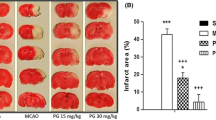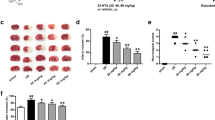Abstract
Cordymin is a peptide purified from the medicinal mushroom Cordyceps sinensis. The present study investigated the effects of Cordymin in prevention of focal cerebral ischemic/reperfusion (IR) injury. The right middle cerebral artery occlusion model was used in the study. The effects of Cordymin on mortality rate, neurobehavior, grip strength, glutathione content, lipid Peroxidation, glutathione peroxidase activity, glutathione reductase activity, catalase activity, Na+K+ATPase activity glutathione S transferase activity and on the regulation of C3 and C4 protein level, polymorphonuclear cells, interleukin-1β and tumor necrosis factor-α in a rat model were studied respectively. Treatment (orally) of Cordymin significantly boosted the defense mechanism against cerebral ischemia by increasing antioxidants activity related to lesion pathogenesis. Restoration of the antioxidant homeostasis in the brain after reperfusion may have helped the brain recover from ischemic injury. Moreover, Cordymin significantly inhibited infiltration of polymorphonuclear cells and IR-induced up-regulation of the brain production of C3 protein level, interleukin-1β and tumor necrosis factor-α. Cordymin significantly improved the outcome in rats after cerebral ischemia and reperfusion in terms of neurobehavioral function. Our findings suggest that cordymin have a neuroprotective effect in the ischemic brain, which is due to the inhibition of inflammation and increase of antioxidants activity related to lesion pathogenesis. Cordymin can be used as potential preventive agent against cerebral ischemia-reperfusion injury.




Similar content being viewed by others
References
Ali A, Ahmad FJ, Pillai KK, Vohora D (2004) Evidence of the antiepileptic potential of amiloride with neuropharmacological benefits in rodent models of epilepsy and behavior. Epilepsy Behav 5:322–328
Bains JS, Shaw CA (1997) Neurodegenerative disorders in humans: The role of glutathione in oxidative stress-mediated neuronal death. Brain Res Rev 25:335–338
Cai Z, Pang Y, Lin S, Rhodes PG (2003) Differential roles of tumor necrosis factor-alpha and interleukin-1 beta in lipopolysaccharide-induced brain injury in the neonatal rat. Brain Res 975:37–47
Cakosiñski I, Dobrzyñski M, Cakosiñska M, Seweryn E, Bronowicka-Szydeko A, Dzierzba K, Ceremuga I, Gamian A (2009) Characterization of an inflammatory response (Polish). Post Hig Med Doœw 63:395–408
Caliborne A (1985) Catalase activity. In: Wakd G (ed) CRC hand book of methods for oxygen radical research. CRC Press, Boca Raton, pp 283–294
Carlberg I, Mannerviek B (1975) Glutathione reductase levels in rat brain. J Biol Chem 250:5475–5480
Coyle JT, Puttfarcken PO (1993) Oxidative stress, glutamate and neurodegenera-tive disorders. Science 262:689–695
Guo JY, Li CY, Ruan YP, Sun M, Qi XL, Zhao BS, Luo F (2009) Chronic treatment with celecoxib reverses chronic unpredictable stress-induced depressive-like behavior via reducing cyclooxygenase-2 expression in rat brain. Eur J Pharmacol 612:54–60
Guo JY, Han CC, Liu YM (2010) A contemporary treatment approach to both diabetes and depression by Cordyceps sinensis, rich in vanadium. Evid Based Complement Alternat Med 7:387–389
Guo J, Li C, Wang J, Liu Y, Zhang J (2011) Vanadium-Enriched Cordyceps sinensis, a Contemporary Treatment Approach to Both Diabetes and Depression in Rats. Evid Based Complement Alternat Med 2011:450316
Habig WH, Pabst MJ, Jakoby WB (1974) Glutathione S-transferases. The first enzymatic step in mercapturic acid formation. J Biol Chem 249:7130–139
Kamboj SS, Chopra K, Sandhir R (2008) Neuroprotective effect of N-acetylcysteine in the development of diabetic encephalopathy in streptozotocin-induced diabetes. Metab Brain Dis 23:427–443
Kuroda S, Siesjo BK (1997) Reperfusion damage following focal ischemia: pathophysiology and therapeutic windows. Clin Neurosci 4:199–212
Lee EJ, Chen HY, Wu TS, Chen TY, Ayoub IA, Maynard KI (2002) Acute administration of Ginkgo biloba extract (EGb 761) affords neuroprotection against permanent and transient focal cerebral ischemia in Sprague-Dawley rats. J Neurosci Res 68:636–645
Lindsberg PJ, Grau AJ (2003) Inflammation and infections as risk factors for ischemic stroke. Stroke 34:2518–2532
Liu Z, Li P, Zhao D, Tang H, Guo J (2010) Protective effect of extract of Cordyceps sinensis in middle cerebral artery occlusion-induced focal cerebral ischemia in rats. Behav Brain Funct 6:61
Liu Z, Li P, Zhao D, Tang H, Guo J (2011) Anti-inflammation effects of Cordyceps sinensis mycelium in focal cerebral ischemic injury rats. Inflammation 34(6):639–644
Longa EZ, Weinstein PR, Carlson S, Cummins R (1989) Reversible middle cerebral artery occlusion without craniectomy in rats. Stroke 20:84–91
Love S (1999) Oxidative stress in brain ischemia. Brain Pathol 9:119–131
Shah ZA, Namiranian K, Klaus J, Kibler K, Dore S (2006) Use of an optimized transient occlusion of the middl cerebral artery protocol for the mouse stroke model. J Stroke Cerebrovasc Dis 15:133–138
Shivakumar BR, Kolluri SV, Ravindranath V (1995) Glutathione and protein thiol homeostasis in brain during reperfusion after cerebral ischemia. J Pharmacol Exp Ther 274:1167–1173
Svoboda P, Mosinger B (1981) Catecholamines and the brain microsomal Na,K-adenosinetriphosphatase-I. Protection against lipoperoxidative damage. Biochem Pharmacol 30:427–432
Wang X, Feuerstein GZ (2000) Role of immune and inflammatory mediators in CNS injury. Drug News Perspect 13:133–140
Wheeler CR, Salzman JA, Elsayed NM, Omaye ST, Korte DW Jr (1990) Automated assays for superoxide dismutase, catalase, glutathione peroxidase and glutathione reductase activity. Anal Biochem 184:193–199
Wong JH, Wang HX, Ng TB (2008) Marmorin, a new ribosome inactivating protein with antiproliferative and HIV-1 reverse transcriptase inhibitory activities from the mushroom Hypsizigus marmoreus. Appl Microbiol Biotechnol 81:669–674
Wong JH, Ng TB, Wang H, Sze SC, Zhang KY, Li Q, Lu X (2011) Cordymin, an antifungal peptide from the medicinal fungus Cordyceps militaris. Phytomedicine 18:387–392
Xu JA, Hsu CY, Liu TH, Hogan EL, Perot PL Jr, Tai HH (1990) Leukotriene B4 release and polymorphonuclear cell infiltration in spinal cord injury. J Neurochem 55:907–912
Zhu JS, Halpern GM, Jones K (1998) The scientific rediscovery of an ancient Chinese herbal medicine: Cordyceps sinensis. J Altern Complem Med 4:289–303
Acknowledgments
This work was supported by National Natural Science Foundation of China(No.81173166);China Postdoctoral Science Foundation Special Project(No.2010030224);China Postdoctoral Science Foundation (No.20090450546), the project from Key Laboratory of Mental Health, Chinese Academy of Sciences, NNSF grant (30800301, 31170992), the Key New Drugs Innovation project from Ministry of Science and Technology (2010ZX09102-201-018) and the Knowledge Innovation Program of the Chinese Academy of Sciences (KSCX2-YW-R-254, KSCX2-EW-Q-18 and KSCX2-EW-J-8).
Author information
Authors and Affiliations
Corresponding authors
Rights and permissions
About this article
Cite this article
Wang, J., Liu, YM., Cao, W. et al. Anti-inflammation and antioxidant effect of Cordymin, a peptide purified from the medicinal mushroom Cordyceps sinensis, in middle cerebral artery occlusion-induced focal cerebral ischemia in rats. Metab Brain Dis 27, 159–165 (2012). https://doi.org/10.1007/s11011-012-9282-1
Received:
Accepted:
Published:
Issue Date:
DOI: https://doi.org/10.1007/s11011-012-9282-1




